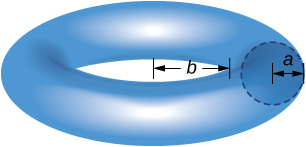1.5E: Exercises
This page is a draft and is under active development.
( \newcommand{\kernel}{\mathrm{null}\,}\)
Moments and Centers of Mass
For the following exercises, calculate the center of mass for the collection of masses given.
Exercise 1.5E.1
m1=2 at x1=1 and m2=4 at x2=2
- Answer
-
Add texts here. Do not delete this text first.
Exercise 1.5E.2
m1=1 at x1=−1 and m2=3 at x2=2
- Answer
-
54
Exercise 1.5E.3
m=3 at x=0,1,2,6
- Answer
-
Add texts here. Do not delete this text first.
Exercise 1.5E.4
Unit masses at (x,y)=(1,0),(0,1),(1,1)
- Answer
-
(23,23)
Exercise 1.5E.5
m1=1 at (1,0) and m2=4 at (0,1)
- Answer
-
Add texts here. Do not delete this text first.
Exercise 1.5E.6
m1=1 at (1,0) and m2=3 at (2,2)
- Answer
-
(74,32)
For the following exercises, compute the center of mass x–.
Exercise 1.5E.7
ρ=1 for x∈(−1,3)
- Answer
-
Add texts here. Do not delete this text first.
Exercise 1.5E.8
ρ=x2 for x∈(0,L)
- Answer
-
3L4
Exercise 1.5E.9
ρ=1 for x∈(0,1) and ρ=2 for x∈(1,2)
- Answer
-
Add texts here. Do not delete this text first.
Exercise 1.5E.10
ρ=sinx for x∈(0,π)
- Answer
-
π2
Exercise 1.5E.11
ρ=cosx for x∈(0,π2)
- Answer
-
Add texts here. Do not delete this text first.
Exercise 1.5E.12
ρ=ex for x∈(0,2)
- Answer
-
e2+1e2−1
Exercise 1.5E.13
ρ=x3+xe−x for x∈(0,1)
- Answer
-
Add texts here. Do not delete this text first.
Exercise 1.5E.14
ρ=xsinx for x∈(0,π)
- Answer
-
π2−4π
Exercise 1.5E.15
ρ=√x for x∈(1,4)
- Answer
-
Add texts here. Do not delete this text first.
Exercise 1.5E.16
ρ=lnx for x∈(1,e)
- Answer
-
14(1+e2)
For the following exercises, compute the center of mass (ˉx,ˉy). Use symmetry to help locate the center of mass whenever possible.
Exercise 1.5E.17
ρ=7 in the square 0≤x≤1,0≤y≤1
- Answer
-
Add texts here. Do not delete this text first.
Exercise 1.5E.18
ρ=3 in the triangle with vertices (0,0),(a,0), and (0,b)
- Answer
-
(a3,b3)
Exercise 1.5E.19
ρ=2 for the region bounded by y=cos(x),y=−cos(x),x=−π2, and x=π2
- Answer
-
Add texts here. Do not delete this text first.
For the following exercises, use a calculator to draw the region, then compute the center of mass (ˉx,ˉy). Use symmetry to help locate the center of mass whenever possible.
Exercise 1.5E.20
The region bounded by y=cos(2x),x=−π4, and x=π4
- Answer
-
(0,π8)
Exercise 1.5E.21
The region between y=2x2,y=0,x=0, and x=1
- Answer
-
Add texts here. Do not delete this text first.
Exercise 1.5E.22
The region between y=54x2 and y=5
- Answer
-
(0,3)
Exercise 1.5E.23
Region between y=√x,y=ln(x),x=1, and x=4
- Answer
-
Add texts here. Do not delete this text first.
Exercise 1.5E.24
The region bounded by y=0,x24+y29=1
- Answer
-
(0,4π)
Exercise 1.5E.25
The region bounded by y=0,x=0, and x24+y29=1
- Answer
-
Add texts here. Do not delete this text first.
Exercise 1.5E.26
The region bounded by y=x2 and y=x4 in the first quadrant
- Answer
-
(58,13)
For the following exercises, use the theorem of Pappus to determine the volume of the shape.
Exercise 1.5E.27
Rotating y=mx around the x-axis between x=0 and x=1
- Answer
-
Add texts here. Do not delete this text first.
Exercise 1.5E.28
Rotating y=mx around the y-axis between x=0 and x=1
- Answer
-
mπ3
Exercise 1.5E.29
A general cone created by rotating a triangle with vertices (0,0),(a,0), and (0,b) around the y-axis. Does your answer agree with the volume of a cone?
- Answer
-
Add texts here. Do not delete this text first.
Exercise 1.5E.30
A general cylinder created by rotating a rectangle with vertices (0,0),(a,0),(0,b), and (a,b) around the y -axis. Does your answer agree with the volume of a cylinder?
- Answer
-
πa2b
Exercise 1.5E.31
A sphere created by rotating a semicircle with radius a around the y-axis. Does your answer agree with the volume of a sphere?
- Answer
-
Add texts here. Do not delete this text first.
For the following exercises, use a calculator to draw the region enclosed by the curve. Find the area M and the centroid (ˉx,ˉy) for the given shapes. Use symmetry to help locate the center of mass whenever possible.
Exercise 1.5E.32
Quarter-circle: y=√1−x2,y=0, and x=0
- Answer
-
(43π,43π)
Exercise 1.5E.33
Triangle: y=x,y=2−x, and y=0
- Answer
-
Add texts here. Do not delete this text first.
Exercise 1.5E.34
Lens: y=x2 and y=x
- Answer
-
(12,25)
Exercise 1.5E.35
Ring: y2+x2=1 and y2+x2=4
- Answer
-
Add texts here. Do not delete this text first.
Exercise 1.5E.36
Half-ring: y2+x2=1,y2+x2=4, and y=0
- Answer
-
(0,289π)
Exercise 1.5E.37
Find the generalized center of mass in the sliver between y=xa and y=xb with a>b. Then, use the Pappus theorem to find the volume of the solid generated when revolving around the y-axis.
- Answer
-
Add texts here. Do not delete this text first.
Exercise 1.5E.38
Find the generalized center of mass between y=a2−x2,x=0, and y=0. Then, use the Pappus theorem to find the volume of the solid generated when revolving around the y-axis.
- Answer
-
Center of mass: (a6,4a25), volume: 2πa49
Exercise 1.5E.39
Find the generalized center of mass between y=bsin(ax),x=0, and x=πa. Then, use the Pappus theorem to find the volume of the solid generated when revolving around the y-axis.
- Answer
-
Add texts here. Do not delete this text first.
Exercise 1.5E.40
Use the theorem of Pappus to find the volume of a torus (pictured here). Assume that a disk of radius a is positioned with the left end of the circle at x=b,b>0, and is rotated around the y-axis.

- Answer
-
Find the center of mass (ˉx,ˉy) for a thin wire along the semicircle y=√1−x2 with unit mass. (Hint: Use the theorem of Pappus.)

